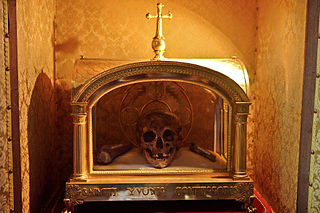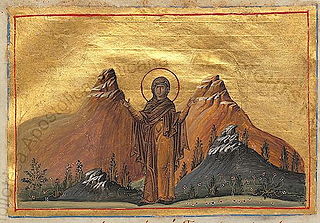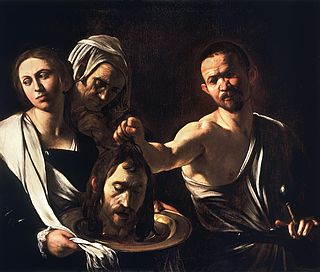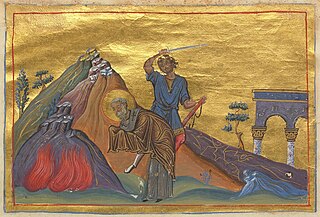
According to apocrypha, as well as Christian and Islamic tradition, Saint Anne was the mother of Mary, the wife of Joachim and the maternal grandmother of Jesus. Mary's mother is not named in the Bible's canonical gospels. In writing, Anne's name and that of her husband Joachim come only from New Testament apocrypha, of which the Gospel of James seems to be the earliest that mentions them. The mother of Mary is mentioned but not named in the Quran.

Flavia Julia Helena, also known as Helena of Constantinople and in Christianity as Saint Helena, was an Augusta of the Roman Empire and mother of Emperor Constantine the Great. She was born in the lower classes traditionally in the Greek city of Drepanon, Bithynia, in Asia Minor, which was renamed Helenopolis in her honor, although several locations have been proposed for her birthplace and origin.

In religion, a relic is an object or article of religious significance from the past. It usually consists of the physical remains or personal effects of a saint or other person preserved for the purpose of veneration as a tangible memorial. Relics are an important aspect of some forms of Buddhism, Christianity, Islam, shamanism, and many other religions. Relic derives from the Latin reliquiae, meaning "remains", and a form of the Latin verb relinquere, to "leave behind, or abandon". A reliquary is a shrine that houses one or more religious relics.

The True Cross is said to be the real cross that Jesus of Nazareth was crucified on, according to Christian tradition.

Phocas, sometimes called Phocas the Gardener, is venerated as a martyr and saint by the Catholic and Eastern Orthodox Churches. His life and legend may have been a fusion of three men with the same name: a Phocas of Antioch, a Phocas the Gardener and Phocas, Bishop of Sinope.

Saint Nino was a woman who preached Christianity in the territory of the Kingdom of Iberia, in what is modern-day Georgia. Her preaching resulted in the Christianization of Iberia.

Thecla was a saint of the early Christian Church, and a reported follower of Paul the Apostle. The earliest record of her life comes from the ancient apocryphal Acts of Paul and Thecla.

September 21 - Eastern Orthodox liturgical calendar - September 23

May 28 - Eastern Orthodox Church calendar - May 30

August 10 - Eastern Orthodox liturgical calendar - August 12

Menas of Egypt, a martyr and wonder-worker, is one of the most well-known Coptic saints in the East and the West, due to the many miracles that are attributed to his intercession and prayers. Menas was a Coptic soldier in the Roman army martyred because he refused to recant his Christian faith. The common date of his commemoration is November 11, which occurs 13 days later on the Julian calendar.

Euphemia, known as Euphemia the All-praised in the Eastern Orthodox Church, was a virgin martyr, who died for her faith at Chalcedon in 303 AD.

The beheading of John the Baptist, also known as the decollation of Saint John the Baptist or the beheading of the Forerunner, is a biblical event commemorated as a holy day by various Christian churches. According to the New Testament, Herod Antipas, ruler of Galilee under the Roman Empire, had imprisoned John the Baptist because he had publicly reproved Herod for divorcing his first wife and unlawfully taking his sister-in-law as his second wife Herodias. He then ordered him to be killed by beheading.
Saints Peter, Andrew, Paul, and Denise are venerated as martyrs by the Eastern Orthodox and Catholic Churches. They were killed in the 3rd century at Lampsacus, Mysia on the Hellespont.

Hieromartyr Phocas was born in the city of Sinope in northern Turkey. During his adult years he became Bishop of Sinope. At the time of persecution against Christians under the emperor Trajan (98–117), the governor demanded that the saint renounce Christ. After fierce torture they enclosed St Phocas in a hot bath, where he died a martyr's death in the year 117.

The Cincture of the Theotokos is believed to be a relic of the Theotokos, now in the Vatopedi monastery on Mount Athos, which is venerated by the Holy Eastern Orthodox Church. The word "cincture" is sometimes also translated as "belt", "sash" or "girdle". It is the Orthodox equivalent of the Girdle of Thomas in the Western church, and the Syriac Holy Girdle. Its feast day is September 13.

December 9 - Eastern Orthodox liturgical calendar - December 11

December 26 - Eastern Orthodox liturgical calendar - December 28

The Holy Girdle, also known as the Girdle of Thomas, Holy Girdle of Mary, Holy Zoonoro, (or) Zunoro, and Holy Belt of Saint Mary the mother of Jesus, is a relic of the Blessed Virgin Mary which is one of the important relics of Syriac Orthodox Church and venerated by Oriental Orthodox communion. The word Zunoro is also translated as "belt", "sash" or "girdle". It is the Oriental Orthodox equivalent of the Girdle of Thomas in the Catholic Church, and the Cincture of the Theotokos in the Eastern Orthodox Church, now located at Mount Athos.













